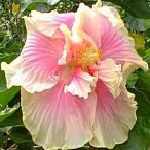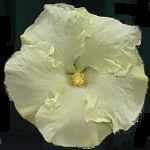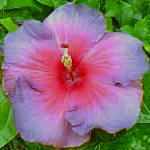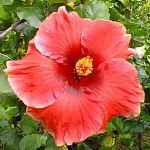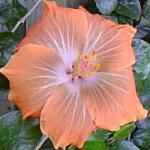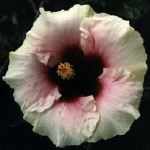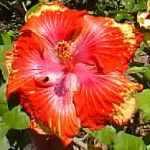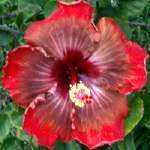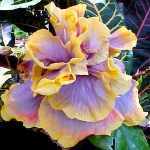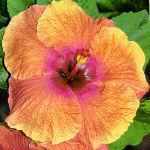 |
|||||||||||||||||||||||||||
| Below are a few common tropical hibiscus questions and brief answers. For much more complete information, consult The Hibiscus Handbook that can be ordered from the society's publications page. Other pages at this site may cover some topics in more detail. Another excellent source of information is our Tropical Hibiscus Mail List - join and ask your questions there. For more information on our mail list go to this page. | |||||||||||||||||||||||||||
| Q. Where can I get the gorgeous varieties I've seen on the Web pages? A. If you live near a chapter of the American Hibiscus Society, give them a call. Other than that, you can contact some of the growers who maintain a presence on the Web. |
|||||||||||||||||||||||||||
|
|||||||||||||||||||||||||||
|
|||||||||||||||||||||||||||
| Q. Do I have to water them every day? A. Hibiscus do not like wet feet, but neither should they be allowed to dry out -- especially in hot weather. Organic matter in the soil and mulch on top help to maintain a constant level of moisture in the summer. In pots or not, good drainage is very important! |
|||||||||||||||||||||||||||
| Q. How much sun? A. They do like a lot of direct light, but under a blazing sun from dawn 'til dusk with temperatures in the 90s, 32+(C) and many of these hybrids will reduce their blooming. A little shade during the heat of the day and they will reward you with more and larger blooms. |
|||||||||||||||||||||||||||
| Q. What do you do with them in the winter? A. In climates where freezes are common, growers will keep all or most of their plants in pots so they can be brought inside - there is a page at this site devoted to this. Another advantage of potted plants is that they can be lain on their side and are, therefore, easier to cover and protect when left outside. Tropical hibiscus can only withstand freezing temperatures for a brief time before there is damage. In milder climates (USDA zones 9&10), if you can trap sufficient ground heat by covering your plants, you may be able to prevent freeze damage to plants in the ground. |
|||||||||||||||||||||||||||
| Q. How and when do I prune? A. It's best to prune when the tender new growth that results won't have near-freezing temperatures to contend with. Many will prune a third to a half of a plant at a time so that they will still get some blooms from the unpruned branches. Use sharp shears and prune just above an "eye." |
|||||||||||||||||||||||||||
|
|||||||||||||||||||||||||||
| Q. What pests attack hibiscus and how do you control them? A. Try to control aphids, thrips whiteflies and spider mites before they have established themselves. Please see our page on insects. Remember that a happy and healthy plant has a better chance of dealing with insects and diseases. |
|||||||||||||||||||||||||||
| Q. Why does my hibiscus have yellow leaves? A. Basically, for two reasons: 1. The leaves are old and the plant is discarding them. 2. The plant is under some stress. That stress may be from a too strong dosage of fertilizer it recently got or its soil has been too wet recently or some insecticide was applied improperly or its root system was disrupted or lighting conditions in a new location are very different from the old one. It could also be a disease. There are many possible reasons. Sometimes yellow leaves (from stress) are indicative of a problem and sometimes it simply indicates a temporary discomfort the plant is having. |
|||||||||||||||||||||||||||
|
|||||||||||||||||||||||||||
| Q. What kind of fertilizer do you use and how often? A. Many use a higher nitrogen fertilizer in the spring and shift to a higher potassium fertilizer in the summer. Often, growers recommend low phosphorous fertilizer to promote blooms. Some use only a 10-10-10. For potted plants, many think a 20-10-20, water soluble product, is ideal. Don't forget that your fertilizers should have the minor elements like iron, copper, manganese, etc. Fertilize lightly and often, especially at the beginning and during the growing season. Timed release fertilizers are very popular. A pH of 5.5 to 7.8 is okay, but some recommend 6 to 7 for best results. Nutrients may not be properly absorbed and plant performance will suffer drastically if far outside these ranges. |
|||||||||||||||||||||||||||
| Q. What causes my buds to drop before the bloom opens? A. Buds are very sensitive and if your plant is under stress from too much or too little water or fertilizer, thrips or other factors, the buds may fall. Also, some varieties (particularly doubles) are more prone to bud drop. |
|||||||||||||||||||||||||||
|
|||||||||||||||||||||||||||
| Q. What type of soil should I use? A. A sandy soil rich in organic matter that will retain water is ideal. Mulching aids moisture retention and shields the roots from the summer sun. For potted plants, some growers prefer a commercial soilless mixture and others prefer a mixture that contains sharp sand for aeration, pine bark grit and fines and larger bits, topsoil, compost. An ideal soil pH is 6 to 7. Hard water and proximity to things like concrete will reduce the acidity the plant wants. |
|||||||||||||||||||||||||||
|
|||||||||||||||||||||||||||
| Q. How do I get my hibiscus to be bushy? A. By careful pruning and pinching back of new growth, you can shape your hibiscus. Some varieties make magnificent bushes and excellent hedges, while others may tend to be spindly. Each variety seems to have its own "personality." |
|||||||||||||||||||||||||||
| Q. Do they do as well in pots as in the ground? A. Given the choice, many growers prefer pots because if a plant isn't thriving in one area it may do better in a different location. Also, applications of fertilizer, etc. are slower to leave the root area if the plants are in pots - less risk of nematodes, too. On the other hand, forgetting the dangers of freeze damage, plants in the ground benefit from being able to spread their roots farther and will need less frequent watering. Also, remember that a leafy plant needs much more water than one with few leaves. Giving both the same amount of water and they both will not thrive -- unless excess water is able to drain. The do not like to sit in soggy soil!!! |
|||||||||||||||||||||||||||
| Q. How long do tropical hibiscus plants live? A. Some of the older garden varieties have been known to live for 50 years or more. Some of the newer hybrids may have lifespans of 5-10 years. |
|||||||||||||||||||||||||||
|
|||||||||||||||||||||||||||
| Q. How can I propagate hibiscus.? A. Some varieties will root easily in a medium like perlite using rooting hormones, while others are very difficult to root. Air-layering can also be used. Propagation of hybrids is usually done by grafting to a proven rootstock variety to assure vigor and to efficiently use the hybrids' wood. |
|||||||||||||||||||||||||||
|
|||||||||||||||||||||||||||
| Q. My hybrid hibiscus is blooming with a different bloom, why? A. Probably it's the rootstock that's blooming. A vigorous rootstock, if allowed to grow, may "overpower" the grafted part -- any new growth (suckers) below the graft should be carefully removed to prevent this. Also, if the grafted, upper part has been killed, any new blooms will be from the surviving rootstock variety. |
|||||||||||||||||||||||||||
| Q. Can I propagate my hibiscus from seed? A. Yes, but because of the complex genetics of today's varieties, unless yours is a species hibiscus (unlikely), any seeds your plant produces will likely produce seedlings that have different bloom and plant characteristics . If you used pollen from a different variety, the odds are that it will share properties of both parents. To get a plant to produce a pod, it needs to be a variety that is a "willing" seed producer and you need fresh pollen from a variety that has potent pollen. With temperatures between 60 and 80F degrees and high humidity and these "willing" parents, your chances are improved. The fresh pollen is applied to the stigma pads at the end of the style. If you have been successful, after the flower falls off, a pod will begin to form. After 6-10 weeks this pod (about the size of the end of your thumb) will turn brown (ripen) and open -- exposing black seeds about the size of apple seeds. Sometimes, even with "willing" parents and ideal conditions, it can be very difficult to get seeds. |
|||||||||||||||||||||||||||
| Q. Do the blooms only last a day? A. If left on the plant or cut and brought inside (no water necessary), the blooms of most varieties last only a day. There are a few whose blooms look good after 2 or 3 days. When cooler weather slows the plants' processes, blooms do last longer than during the summer. |
|||||||||||||||||||||||||||
|
|||||||||||||||||||||||||||
| Q. Why isn't my plant blooming like it did last year? A. Perhaps frost damaged the upper plant and it's still recovering. |
|||||||||||||||||||||||||||
|
|||||||||||||||||||||||||||
| Q. How do I "jump start" my hibiscus after winter? A. A higher nitrogen fertlizer and a careful pruning will usually trigger healthy new growth. Fish emulsion solutions are used by many growers. |
|||||||||||||||||||||||||||
| Q. What diseases can damage my hibiscus? A. Occasionally, bacterial and viral diseases may threaten a plant. Try to avoid spreading these problems by sterilizing shears and isolating the affected plant if possible. Plants that cannot be revived should be carefully discarded. Try to consult an expert. Many diseases can be cured with the proper treatment. Sometimes something as simple as adding a weak chlorine bleach solution to the soil may kill the pathogen and sometimes a specialized product is necessary. Again, remember that a properly watered and fertilized plant is better able to resist problems. |
|||||||||||||||||||||||||||
|
|||||||||||||||||||||||||||
| Q. How large will they grow? A. Some of the garden varieties may grow to heights of 10-15 feet or even more. Most of the hybrids won't get nearly that large, in fact, some may only grow a few inches a year. Being in the ground or in a pot and pot size are also factors. |
|||||||||||||||||||||||||||
| If you would like to join our tropical hibiscus discussion group (mail list)? Click and send the blank message. | |||||||||||||||||||||||||||
|
| q&a | brief background | fert.,insect. | propagation | growing up north | | Amer.H.S. | shows | mail list | links | Return to: Hibiscus Home Page |
|||||||||||||||||||||||||||
